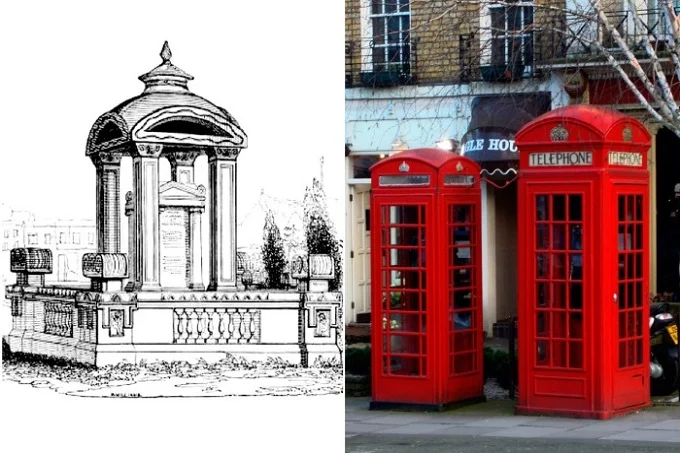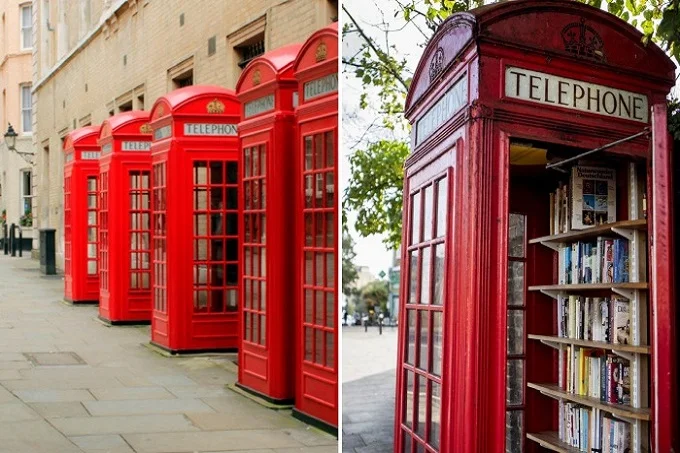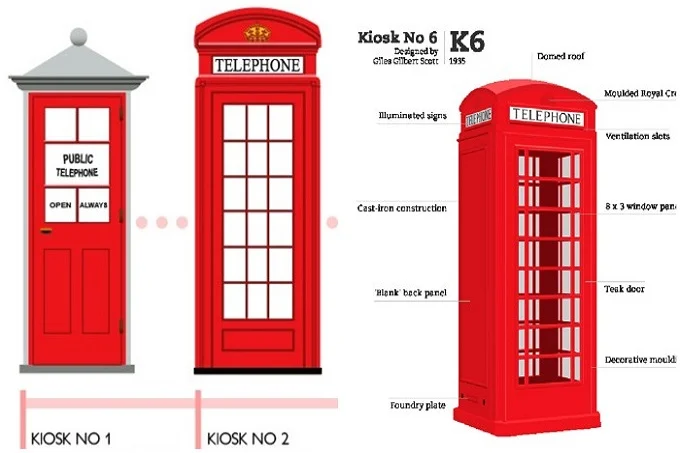Why English phone booths are red?

Alexander Bell, a Scottish physicist, invented the telephone, which swiftly achieved international fame and extensive usage. Despite the fact that it was invented in 1876 and was plainly not accessible to everyone at the time, the world’s the first public telephone was built in Great Britain just eight years later. But why are English telephone booths red?
The contemporary traveler finds it impossible to envisage a trip to the United Kingdom without taking a picture with the renowned red telephone booth. Like the double-decker bus and the English breakfast, it has become a vital feature of urban architecture and an icon of the United Kingdom.
When and who created the traditional English telephone box?
The unique hardware gadget has been aggressively incorporated into the lives of ordinary people since the development of the telephone. However, there were certain issues with it, the primary one being how to make telephone communication accessible to all London inhabitants at any time of day or night.
The best answer was to establish public telephones that practically everyone could use. Telephones were originally introduced at railway stops, businesses, and hotels. They were only isolated from the city’s commotion and attention by a flimsy canvas barrier. Aside from these unsettling considerations, a significant disadvantage of such telephone systems was the short operating period of public buildings.
As it became evident that this site was cumbersome over time, the city decided to equip the busiest areas with tiny specialized booths.

The earliest boxes were made of wood, which did not fulfill expectations, but the concept progressed, and in 1924, the City of London conducted a competition to create the greatest telephone booth for the British capital. Sir Giles Gilbert Scott won the competition with his design for a silver-colored cast-iron kiosk with big glass windows and an arched top. Scott is well noted for his work on the Cathedral Church of Christ in Liverpool and the tower of the Cambridge University Library.
What caused London’s phone booth to become red?
Organized by the District Metropolitan Joint Committee and the Royal Commission of the Visual Arts, the competition was designed to end the fragmentation of telephone booths across the country and to unify their appearance.
Architect Sir Scott’s design was unanimously voted the best, but the color scheme remained controversial. Scott believed that the silver box would delight passers-by with a subtle shine in daylight.
Some opponents argued that the red paint would distract drivers and obstruct traffic. Be that as it may, the British payphone has outlived its creators and has long served not only to help people communicate across kilometers but also as a temporary shelter from unexpected rain.
In the 21st century, a red telephone box is less and less common on the streets of British cities. Of the 150,000 copies, just over 10,000 remained in the country. The red telephone booth is now more of an antique, a symbol of the era that is now resting on its laurels. There is still a working original near the Royal Academy of Arts in London, but most of them no longer fulfill their direct purpose.
Features of the English style
In 1926, the telephone booth received the Tudor crown at the top, which symbolized the British monarchy. This decorative element was first used in Sir Scott’s project in Kiosk No.2. After 1955, telephone booths with the Imperial Crown were replaced by a new design featuring the Scottish Crown in Scotland.
The kiosk dome is a characteristic feature of all of Scott’s projects, it serves as a reference to the family crypt of Sir John Soane, the famous Palladian architect of the Georgian Regency era, whose work was a great fan of Scott.
The neoclassical kiosk was modern and functional for the late 19th century. A sophisticated ventilation system (perforated holes) was installed in the dome. The glass was split into small pieces (18 pieces on each of the three sides) so that it could be quickly replaced if it broke.
K6 – the iconic version of the English telephone booth
K6 is a modernized version designed by Scott to commemorate King George V’s “Silver Jubilee” (25th anniversary of his accession to the throne) in 1935. It is much more compact and lighter than its “big brother” K2 (height 2.51 m versus 2.82 m; width 0.9 m versus 1.07 m; weight 0.69 tonnes versus 1.27 tonnes), as well as cheaper in production. The cup-handle doors are made of teak, the base is concrete, and the main structural elements are cast iron. And the Tudor crown on the dome is a relief structure without holes.

The vents are hidden under illuminated frosted glass plates. The distribution of the windows has been reduced to eight, with a large center window to provide more light. The project fully corresponded to the spirit of the period when the Art Deco style dominated Britain. The appearance of the booth is laconic and simple, with a minimum of classic details.
The K6 booth gained immense popularity in the United Kingdom, with about 60,000 booths of this model installed between 1935 and 1968.
In the modern world, when highly developed and inexpensive technologies allow almost everyone to have a personal phone in their pocket, practically no one remembers about fixed handsets, and the telephone booth is a thing of the past.
Since 2014, modern green booths have replaced the legendary “fiery old women”, keeping up with the times and technologies. You cannot make phone calls from them, but you can recharge your smartphone or other devices. New telephone booths are powered by solar panels. Nonetheless, red telephone booths still thrill tourists, such as the world’s most poisonous garden, which is located in England.




